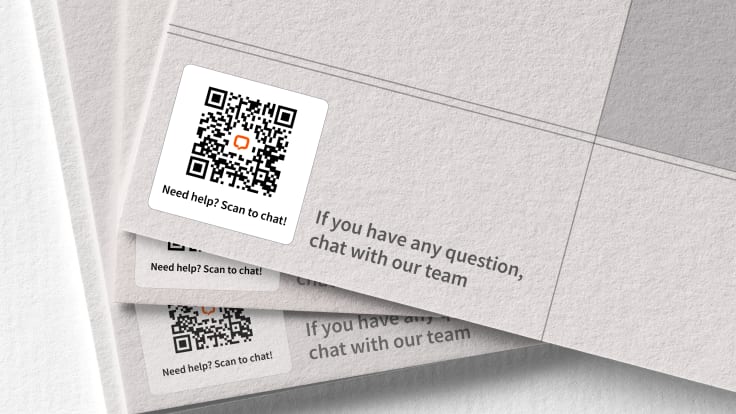Showing top 0 results 0 results found
Showing top 0 results 0 results found

Picture a curious customer entering a tech store, convinced their new smartphone should have a "caffeine infusion" feature to keep them awake during endless video calls. While chuckle-worthy, such moments illuminate the need for retailers to infuse creativity into problem-solving, turning amusing requests into chances to exceed customer expectations.
The retail landscape is a dynamic arena where customer service is a linchpin for success. Retailers grapple with challenges that demand creative solutions while uncovering exciting growth opportunities.
Understanding customer expectations
The days of clunky processes and disjointed customer journeys are behind us. Seamless is the keyword. Customers want the transition from online to in-store, from browsing to purchasing, to be as smooth as butter. It's about creating an experience where the customer doesn't feel the gears turning. Instead, they effortlessly glide through a journey crafted just for them.
Customers desire a unified and cohesive experience where the online information, products, and services align seamlessly with what is offered in-store. This integration could include consistent pricing, product availability, promotional offers, and a coherent brand experience. It reflects the modern customer's desire for a holistic and connected journey, where their interactions with a brand, whether online or in-store, feel interconnected and complementary rather than disjointed.
Today's customers are savvy and well-informed, with unique needs and preferences. They crave a customer service experience that resonates with them. They're seeking a connection. Whether remembering their favorite color, suggesting products based on past purchases, or simply addressing them by name, personalization will never get boring. It's like having a favorite barista who knows your coffee order by heart – that level of familiarity and attention is what customers are after.
Every retail store can transform transactions into lasting connections, providing exceptional customer service and making every customer feel like the protagonist.
Key elements of excellent customer service in retail
So, how do you improve customer experience in retail stores? Here are a few main steps that you should focus on.
Proactive communication, AKA good customer service
Imagine if your favorite store's communication was like having a quick chat with a friend – not too much, not too little, just right. Proactive communication is about finding that sweet spot. It's like when your friend texts you about an upcoming sale just as you think about a shopping spree.
In retail, it's about anticipating customer needs, providing timely information, and doing it all with a sprinkle of friendliness.
Retail customer service example:
You order a pair of shoes, and before tapping your foot impatiently, the store sends you a playful message saying, "Hang tight! Your shoes are doing a little happy dance on their way to you!" Proactive, engaging, and smile-inducing.
Turning "oops" into "wow" for improved customer loyalty
We've all been there – a mix-up with an order or a product not meeting expectations. But what if you scan a QR code and chat with a customer service representative filled with positive energy instead of dreading the extended waiting customer service hotline? It's like having a magician fix a broken wand, making it even more magical.

Retail customer service example:
You receive a package, and oh no, something is amiss. You reach out to customer service, expecting a mundane exchange, but instead, they respond with a virtual high-five, a sincere apology, and a little surprise in your next order. It's not just problem-solving; it's turning frowns into smiles with a dash of unexpected delight.
Leveraging technology for a smooth customer experience
Technology is the wizard behind the retail curtain, making things happen like magic. Have you ever chatted with a friendly chatbot that understands your queries and cracks a joke or two? That's the kind of tech we're talking about.
For instance, integrating LiveChat with Salesforce combines the power of real-time communication through LiveChat with robust customer relationship management (CRM) capabilities.
Customer service example:
A customer is browsing your online store, and instead of waiting for an email response, they engage in a LiveChat conversation. Here's where the magic unfolds – as they chat, Salesforce is quietly working behind the scenes, pulling up the customer's purchase history, preferences, and even their recent interactions with your brand. It's like having a conversation with a friend who remembers every detail.
LiveChat-Salesforce creates an experience where customers feel genuinely understood.
Creating a customer-centric culture within retail teams
Fostering a customer-focused mindset among customer service agents involves implementing strategies prioritizing customer satisfaction and engagement. Here are some effective strategies:
1. Comprehensive training programs:
- Develop training programs that emphasize the importance of customer service. Provide team members with the necessary skills, tools, and knowledge to understand and meet customer needs. Include modules on active listening, empathy, and problem-solving.
2. Lead by example:
- Leadership plays a crucial role in shaping organizational culture. Leaders should embody and demonstrate a customer-centric mindset. Leaders set the standard for the entire team to follow by showcasing customer-focused behaviors and values.
3. Customer-centric metrics:
- Establish key performance indicators (KPIs) that directly measure customer satisfaction. This could include metrics like the net promoter score (NPS), customer feedback ratings, and resolution times. Regularly communicate these metrics to the team, emphasizing their contribution to positive customer experiences.
4. Customer persona workshops:
- Conduct workshops to create customer personas. Help team members understand the diverse needs and preferences of different customer segments. This exercise humanizes the customer, making it easier for agents to connect with and address their specific requirements.
5. Encourage customer feedback:
- Actively seek and encourage customer feedback. Provide channels for customers to share their experiences and opinions. Make it a part of team discussions, celebrate positive feedback, and use constructive criticism for improvement.
6. Recognition and rewards:
- Implement recognition and reward programs to acknowledge employees who consistently provide exceptional customer service. This creates a positive feedback loop within the customer service team.
7. Regular communication:
- Maintain open and transparent communication channels within the team. Regularly discuss customer success stories, challenges, and best practices. This fosters a sense of shared responsibility for customer satisfaction.
8. Cross-functional collaboration:
- Encourage collaboration between different departments to ensure a holistic approach to customer service. Break down silos and emphasize that every team member, regardless of their role, plays a part in delivering great customer service.
9. Continuous learning:
- Foster a culture of continuous learning. Keep the team informed about industry trends, emerging customer expectations, and new technologies. This ensures that employees stay adaptable and responsive to evolving customer needs and strive to improve customer service.
10. Empowerment and autonomy:
- Empower team members to make decisions that prioritize customer satisfaction. Provide them with the autonomy to resolve issues on the spot, reducing the need for unnecessary escalations and demonstrating trust in their customer service skills and ability to serve customers effectively.
By combining these strategies, retail teams can cultivate a customer-focused mindset that permeates every aspect of their interactions, ultimately improving customer satisfaction and loyalty. However, the impact extends beyond individual customer interactions, influencing the business' reputation in the market.
A commitment to exceptional customer service enhances the brand's standing, fostering positive word-of-mouth marketing. Satisfied customers become brand advocates, sharing their positive experiences with friends and family and across social media platforms.
Examples of a successful customer-centric culture
Let's draw inspiration from the success stories of companies that have turned their commitment to customers into a winning formula. Take Zappos, for instance. Their legendary customer service isn't a side act. It's the headline. From surprising customers with overnight shipping upgrades to delivering pizzas during a call, Zappos showcases a culture where every team member is a customer advocate.
Employee training for excellent retail customer service
The influence of well-trained and empowered staff on customer service extends beyond mere transactions. It's a strategic investment that shapes individual interactions and the brand's overall perception.
Impact of a well-trained staff: proficiency in action
Well-trained staff members are proficient problem solvers. Training equips them with the knowledge and skills to navigate customer interactions effectively, transforming routine engagements into valuable customer experiences.
For instance, a well-trained staff member understands a customer's needs, recommends relevant solutions, and provides insights beyond a simple transaction. This proficiency meets expectations and elevates the interaction, creating a positive impression of your retail store.
Empowerment: fostering initiative and adaptability
Empowering staff is about going beyond a set script. It's cultivating a culture where employees are encouraged to take initiative and adapt to unique situations. An empowered employee is not confined by rigid rules but is given the autonomy to find creative solutions that align with the brand's commitment to customer satisfaction.
Imagine a scenario where a customer presents a challenge outside the norm. An empowered staff member doesn't hesitate to take the initiative, finding innovative solutions that address the immediate concern and leave a positive and lasting impact on the customer.
You might also want to check out Welcome Messages on Chat
Metrics and measurement customer service in retail
Measuring customer service effectiveness is a compass that guides your retail business toward success. KPIs serve as milestones, while feedback loops and continuous improvement become the wind beneath the sails, propelling the journey towards enhanced customer satisfaction.
KPIs for retail customer service:
1. Customer satisfaction score (CSAT):
- CSAT is a direct reflection of customer contentment. By regularly measuring satisfaction through post-purchase surveys or feedback forms, businesses gain insights into the overall effectiveness of their customer service.
2. Net promoter score (NPS):
- NPS gauges customer loyalty by asking, "How likely are you to recommend our product/service to a friend?" This metric not only measures satisfaction but also identifies potential brand advocates.
3. First contact resolution (FCR):
- FCR measures the ability of customer service to resolve issues in the initial interaction. A high FCR indicates efficiency and a positive customer experience, reducing the need for customers to follow up repeatedly.
4. Average resolution time:
- This metric quantifies the average time it takes to resolve customer issues. Faster resolutions increase customer satisfaction, signaling effective problem-solving and service efficiency.
5. Customer effort score (CES):
- CES evaluates the ease with which customers can resolve issues. It sheds light on the simplicity of the customer service process, as perceived by the customers themselves.
6. Repeat customer rate:
- A loyal customer is a satisfied customer. Tracking the percentage of repeat customers who return for additional purchases provides insights into the success of customer service in fostering brand loyalty.
7. Social media mentions and sentiment:
- The power of social media cannot be underestimated. Monitoring mentions, reviews, and sentiments on social platforms provides real-time feedback and an understanding of how customers perceive the brand.
You might also want to check out Sales Metrics and KPIs you Should Track
Importance of feedback loops and continuous improvement
1. Real-time feedback mechanisms:
- Implementing real-time feedback mechanisms, such as instant surveys or customer support chat feedback, allows you to capture insights when experiences are fresh. This agility enables swift adjustments and improvements.
2. Regular customer surveys:
- Conducting periodic customer surveys provides a comprehensive understanding of overall satisfaction, areas for improvement, and emerging trends in customer expectations. These insights form the basis for strategic adjustments in customer service approaches.
3. Employee feedback:
- Employees are the frontline ambassadors of customer service. Regularly seeking feedback from the staff about customer interactions, challenges faced, and potential improvements offers valuable perspectives for refining training programs and service strategies.
4. Benchmarking against industry standards:
- Benchmarking customer service metrics against industry standards allows businesses to gauge their performance compared to peers. It provides context for identifying areas of strength and opportunities for improvement.
5. Root cause analysis:
- Conducting a thorough root cause analysis helps uncover the underlying factors when issues arise. This process is crucial for implementing targeted improvements rather than addressing only surface-level concerns.
6. Flexibility and adaptability:
- The retail landscape is dynamic, and customer expectations evolve. Continuous improvement requires a mindset of flexibility and adaptability. Businesses must be willing to adjust strategies based on feedback and emerging trends.

Handling challenging situations in retail customer service
Dealing with angry customers and navigating challenging situations is a vital skill that improves customer engagement and loyalty. Let's see common examples and strategies that help improve customer service in retail.
1. Active listening and empathy:
- Guidance: Start with active listening. Allow the customer to express their concerns fully and show genuine empathy. Acknowledge their feelings and reassure them that their feedback is valued.
- Why it works: Active listening builds trust and demonstrates a commitment to understanding the customer's perspective.
2. Apologize and take responsibility:
- Guidance: Offer a sincere apology, even if the issue isn't directly the business' fault. Taking responsibility and expressing regret can defuse tension.
- Why it works: A genuine apology shows humility and a commitment to customer satisfaction, fostering a positive atmosphere for resolution.
3. Seek solutions together:
- Guidance: Involve the customer in finding a solution. Collaborate on resolving the issue, asking for their input and preferences.
- Why it works: This collaborative approach empowers the customer and transforms the interaction into a shared problem-solving experience.
4. Offer alternatives or compensation:
- Guidance: Present customers with alternatives or compensation to make amends. This could be through discounts, vouchers, or additional services.
- Why it works: Offering solutions showcases a commitment to rectifying the situation and turning a negative experience into a positive one.
5. Follow-up
- Guidance: After implementing a resolution, follow up with the customer to ensure their satisfaction and gather additional feedback.
- Why it works: Following up demonstrates an ongoing commitment to customer care and provides valuable insights for continuous improvement.
Successful resolution strategies for retail customer service
Case study 1: Turning dissatisfaction into loyalty
Situation:
- A customer expressed dissatisfaction with a product purchased online, citing issues with its functionality.
Retail customer service tip:
- The customer service team, through active listening, empathized with the customer's frustration. They offered a replacement product and a personalized note expressing regret. Additionally, they included a discount for the customer's next purchase.
Result:
- The customer accepted the resolution and expressed gratitude for the personalized touch. This proactive approach not only retained the customer but turned them into a loyal brand advocate.
Case study 2: Transforming negative feedback into positive change
Situation:
- Several customers provided feedback about the physical store's need for a user-friendly layout.
Retail customer service tip:
- The retail store management took this feedback seriously and implemented a store layout redesign, emphasizing a more customer-friendly and intuitive arrangement.
Result:
- The store's proactive response to customer feedback improved customer satisfaction scores and increased foot traffic and sales. The negative feedback became a catalyst for positive change.
Challenges are inevitable, but how they are handled can define the customer experience and shape your retail business reputation.
The best retail customer service
Continuous improvement in skills and strategies is the key to delivering unparalleled retail customer service. Prioritizing these efforts creates satisfied customers and cultivates loyalty, transforming one-time buyers into dedicated brand advocates.
In summary, the essence of great customer service in retail lies in recognizing that loyal customers are the heartbeat of your success. You can build lasting connections by consistently refining customer service practices and paving the way for sustained growth.
Get a glimpse into the future of business communication with digital natives.
Get the FREE report








Comments